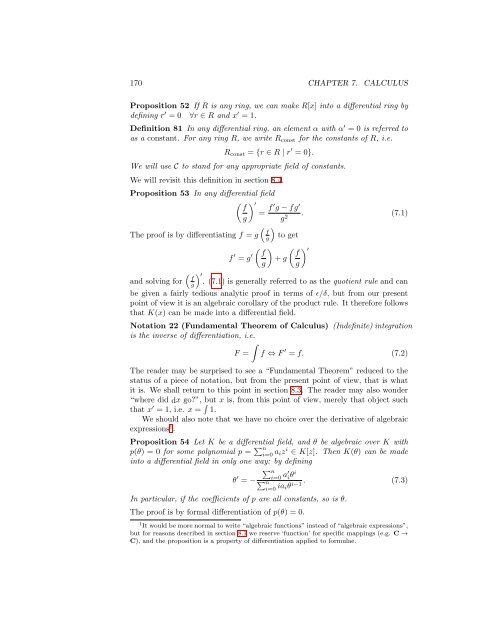Contents - Student subdomain for University of Bath
Contents - Student subdomain for University of Bath
Contents - Student subdomain for University of Bath
Create successful ePaper yourself
Turn your PDF publications into a flip-book with our unique Google optimized e-Paper software.
170 CHAPTER 7. CALCULUS<br />
Proposition 52 If R is any ring, we can make R[x] into a differential ring by<br />
defining r ′ = 0 ∀r ∈ R and x ′ = 1.<br />
Definition 81 In any differential ring, an element α with α ′ = 0 is referred to<br />
as a constant. For any ring R, we write R const <strong>for</strong> the constants <strong>of</strong> R, i.e.<br />
R const = {r ∈ R | r ′ = 0}.<br />
We will use C to stand <strong>for</strong> any appropriate field <strong>of</strong> constants.<br />
We will revisit this definition in section 8.4.<br />
Proposition 53 In any differential field<br />
( ) ′ f<br />
= f ′ g − fg ′<br />
g g 2 . (7.1)<br />
( )<br />
The pro<strong>of</strong> is by differentiating f = g f<br />
g<br />
to get<br />
( ) ( ) ′<br />
f f<br />
f ′ = g ′ + g<br />
g g<br />
and solving <strong>for</strong><br />
(<br />
f<br />
g<br />
) ′.<br />
(7.1) is generally referred to as the quotient rule and can<br />
be given a fairly tedious analytic pro<strong>of</strong> in terms <strong>of</strong> ɛ/δ, but from our present<br />
point <strong>of</strong> view it is an algebraic corollary <strong>of</strong> the product rule. It there<strong>for</strong>e follows<br />
that K(x) can be made into a differential field.<br />
Notation 22 (Fundamental Theorem <strong>of</strong> Calculus) (Indefinite) integration<br />
is the inverse <strong>of</strong> differentiation, i.e.<br />
∫<br />
F = f ⇔ F ′ = f. (7.2)<br />
The reader may be surprised to see a “Fundamental Theorem” reduced to the<br />
status <strong>of</strong> a piece <strong>of</strong> notation, but from the present point <strong>of</strong> view, that is what<br />
it is. We shall return to this point in section 8.3. The reader may also wonder<br />
“where did dx go?”, but x is, from this point <strong>of</strong> view, merely that object such<br />
that x ′ = 1, i.e. x = ∫ 1.<br />
We should also note that we have no choice over the derivative <strong>of</strong> algebraic<br />
expressions 1 .<br />
Proposition 54 Let K be a differential field, and θ be algebraic over K with<br />
p(θ) = 0 <strong>for</strong> some polynomial p = ∑ n<br />
i=0 a iz i ∈ K[z]. Then K(θ) can be made<br />
into a differential field in only one way: by defining<br />
θ ′ = −<br />
∑ n<br />
i=0 a′ i θi<br />
∑ n<br />
i=0 ia . (7.3)<br />
i−1<br />
iθ<br />
In particular, if the coefficients <strong>of</strong> p are all constants, so is θ.<br />
The pro<strong>of</strong> is by <strong>for</strong>mal differentiation <strong>of</strong> p(θ) = 0.<br />
1 It would be more normal to write “algebraic functions” instead <strong>of</strong> “algebraic expressions”,<br />
but <strong>for</strong> reasons described in section 8.1 we reserve ‘function’ <strong>for</strong> specific mappings (e.g. C →<br />
C), and the proposition is a property <strong>of</strong> differentiation applied to <strong>for</strong>mulae.












![[Luyben] Process Mod.. - Student subdomain for University of Bath](https://img.yumpu.com/26471077/1/171x260/luyben-process-mod-student-subdomain-for-university-of-bath.jpg?quality=85)



